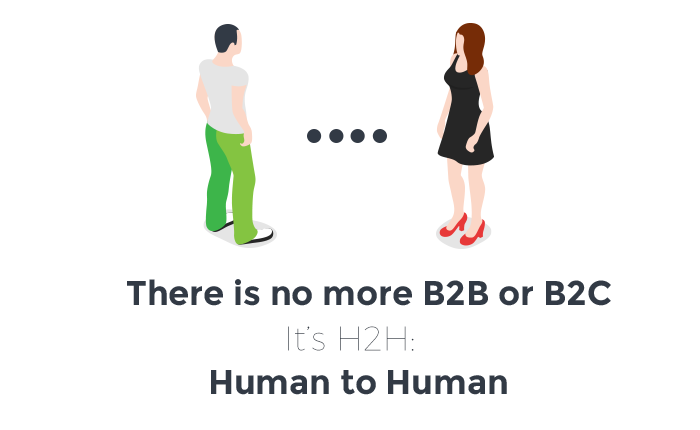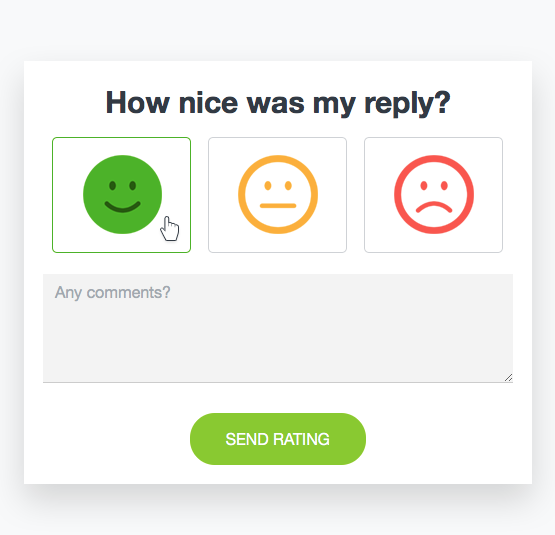Customer satisfaction doesn’t just impact the business’s bottom line, it also impacts team morale and retention rate.
Businesses need money to survive. To make money, businesses need customers. Ideally, these customers are happy, tell their friends about you, and keep coming back.
While your business might survive with angry, single-purchase customers, only businesses with a focus on customer satisfaction will thrive. Customer satisfaction is the difference between surviving and thriving.
Imagine you meet the person of your dreams. However – you have to work a little to win them over. Cue the standard wooing techniques – a sweetly written love letter, an invitation to dinner followed by candlelight romance. Eventually, they fall head over heels in love with you and agree to make a long-term commitment.
What happens next? Do you stop calling? Do you stop worrying about what they think, and how you can keep them happy? If you want to keep them around… probably not.

Customer relationships are no different. Whether you’re in a B2B or B2C marketplace, at the end of the day, you’re living in an H2H world…. human to human. And that’s where the importance of customer satisfaction comes in.
Building relationships with customers
Customer satisfaction is the key to creating a long-term relationship with your customers. If you think back to the dating analogy, going through the sales process is just like wooing your prospect to turn them into a customer.
But keeping a long term relationship functioning is hard work. You need to keep delivering value time and time again. You need to keep your customer satisfied.
- 81% of satisfied customers are more likely to do business with you again if they have a positive experience.
- 95% of customers will “take action” after a negative experience – like sharing concerns with friends and family, or churning.
Ongoing satisfaction leads to loyalty. Once customers have placed trust in a company and are assured that the company will continue to deliver they will continue to do business with them.
Loyalty is a worthy goal to shoot for – the White House Office of Consumer Affairs estimates that loyal customers are worth up to 10 times their initial purchase value.

So once you’ve decided to keep customers satisfied and build a long-term relationship with them, you need to know where you’re going wrong. How do you make sure you’re delivering value and setting your business up for happy customer relationships?
The Cost of Bad Customer Service
Have you ever been out to eat and in order to offset a bad meal the manager removed it from your bill? Maybe brought out a free dessert in hopes of making amends? You may have appreciated the gesture and left satisfied. That doesn’t change the fact that the mistake cost the restaurant money. Whether or not your customer service team handles disputes by offering customer discounts, refunds, or freebies, not handling a situation properly can also affect future profits.
An unhappy customer has a decent amount of power over your brand’s reputation. People are actively searching for unfiltered reviews and discussions before making their purchasing decisions. Filter in that fact that 88% of those people have been influenced by what they’ve found suddenly that a single negative encounter is greatly affecting whether or not you continue to gain new customers. Once your reputation takes a hit it’s almost a dominos effect on sales.
Not only will referrals be affected but, as we know, internet word spreads fast. Soon loyal customers may start to leave. A great example of this has been demonstrated by United Airlines. You might recall the recent bad customer service of United Airlines and how that’s affected them (hint: customers and employees are not happy). It’s a lot more expensive to get a new customer than to keep a current one (like 7 times more).
There’s plenty of evidence that bad customer experience will send people running into the proverbial arms of a competitor. On the flip side, research from Nextiva says Americans will pay 17% more to do business with firms with great reputations when it comes to customer service.
Calculating the Effect of Customer Satisfaction
Customer satisfaction is extremely important to your bottom line. Let’s put it into perspective with numbers.
Take the following business, Purrfect Prints, selling printer supplies.
- They have 100 customers right now
- Each of those customers spends $100 per month on average.
If Purrfect Prints customer satisfaction is at 90% this month, they have 90 happy customers who will likely continue to purchase from them.
They also have 10 customers that are unhappy, and 95% of those might churn. That means Purrfect Prints has $950 of recurring revenue at risk this month.
Next month, things go horribly wrong. Their customer satisfaction is lower at 75%. Purrfect Prints can expect to lose $2375 of recurring revenue from unhappy customers churning.
According to the research, this Purrfect Prints is putting an additional $95 of recurring revenue at risk each month for each percentage point of satisfaction they lose.
If you have more customers, who spend more each month, lower customer satisfaction has an even bigger impact on your business. Every unhappy customer is another hit to the bottom line.
The Feedback of Customer Satisfaction
If customer satisfaction is the goal, then constant feedback is the best way to improve over time. You need to measure customer satisfaction in order to improve it. There are a few ways to measure customer satisfaction, but the most common and effective ways are to simply ask your customer.

Transactional satisfaction
Transactional satisfaction measures how your customers feel after contacting your business. After each reply or interaction, ask the customer how they felt about the exchange. Are they satisfied? Or could you have done more to make them happy?
We’d also recommend following up on the initial question with a probing question to understand where you went wrong, or what you did right. This gives you an opportunity to immediately reach out and rescue the situation if they are unsatisfied.
In order to track your improvement over time, divide the number of Satisfied responses by the total number of responses, and multiply it by 100. (ie. 82 Satisfied Customers out of 100 Total Responses = 82%) This number is typically referred to as CSAT.
Start your day
with great
quality
content
Relational satisfaction
Of course, even if you don’t interact with your customers, they still have an opinion about your company. Measuring satisfaction at regular intervals instead of just after interactions is also important.
Many companies do regular customer satisfaction surveys once or twice a year. It’s a great opportunity to ask more targeted questions about what impacts their relationship with your company.
- How would you feel if [company] wasn’t available tomorrow?
- How likely are you to recommend [company] to friends and family? (The NPS question!)
- What is the one thing we could do to make you happier?
Measuring your customer satisfaction and continuing to seek feedback tells you where improvement is needed. It keeps a constant pulse on the state of your relationship with your customers and provides you with the information needed to do better.
Happy Customers Means Happier Employees
No one likes being yelled at. It’s just not a fun situation to be in. Agents who routinely have to deal with upset customers can find their job draining. It’s even worse if your agents aren’t empowered to resolve the situation. Instead of feeling like part of the solution, your team will feel like a barricade between your customers and the rest of the business. When agents feel drained, uninspired, and ineffective, they don’t tend to stay in their jobs for very long.
Customer satisfaction doesn’t just impact the business’ bottom line, it also impacts team morale and retention rate. Zendesk fully agrees with this. They believe there’s a correlation between CSAT and ASAT (agent satisfaction). When one goes up, so does the other. It’s a positive feedback cycle that leaves everyone feeling happier, more motivated, and satisfied.
TIP: Treat your customers with respect and train your customer service team to do the same. Never leave negative feedback or complaints that go unresolved and truly take the time to take into account all their needs. Especially if their problem will require more than a quick-fix solution.
Importance of Customer Satisfaction
Teams that measure customer satisfaction can easily calculate the expected risk of unhappy customers. By putting a number to the importance of customer satisfaction, you can have more meaningful conversations with your boss and company about investing in your team.
Commit the entire team to improving customer satisfaction day in and day out. Track your progress, for example through client management software, and reap the rewards.
Satisfied customers will recommend you to their network. Customer advocacy is a very efficient form of marketing. Small businesses estimate that 85% of their new business comes from word of mouth. This creates a stronger brand equity for the company.
Satisfied customers will continue to buy from you. Not only do loyal customers spend more long-term, but it’s also cheaper to keep them happy than trying to acquire a new customer. It’s 6 times more expensive to woo that new customer than it is to retain an existing one. (Think about how much you’ve spent on first dates in your lifetime!)
Satisfied customers are better for your sanity. Listening to what customers want means that you won’t be constantly at odds with your clients. Just like arguments in a relationship are emotionally draining, having grumpy customers constantly writing into a support team leads to burnout and a much unhappier work environment.
No one can deny the importance of customer satisfaction. Keeping your customers happy and loyal means more business, longer relationships, and honestly – a much better day at the office!








